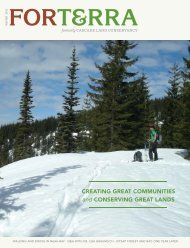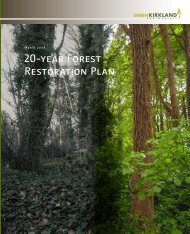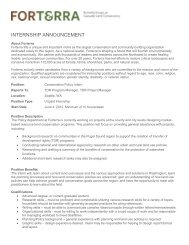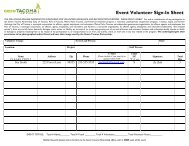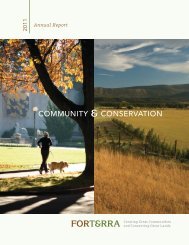Seattle'S ForeSt ecoSyStem ValueS - Forterra
Seattle'S ForeSt ecoSyStem ValueS - Forterra
Seattle'S ForeSt ecoSyStem ValueS - Forterra
Create successful ePaper yourself
Turn your PDF publications into a flip-book with our unique Google optimized e-Paper software.
Executive Summary<br />
Across Seattle, in backyards and lush parklands, along parking lots and on college campuses,<br />
trees and other vegetation make up a dynamic urban forest. For the first time in<br />
history more than 50% of the earth’s population lives in urban areas, and in the United<br />
States over 80% of the population lives in cities. City residents and visitors benefit from a<br />
myriad of services provided by the urban forest. Trees and nature make urban communities<br />
more livable and vibrant.<br />
The Forest Ecosystem Values Project began in 2010 using the USDA Forest Service’s i-<br />
Tree Eco tool to conduct a comprehensive analysis of the current extent and condition of<br />
Seattle’s urban forest. Tree and shrub size and species information was used to quantify<br />
associated ecosystem functions and their public benefits and economic values. This research<br />
produced the following findings about Seattle’s urban forest:<br />
Urban Forest Structure<br />
• The number of trees and tree-like shrubs in Seattle is estimated to be 4.35 million.<br />
This equates to a density of nearly 80 trees and tree-like shrubs per acre.<br />
• The three most common species measured were red alder, big leaf maple, and<br />
beaked hazelnut, which are all native to the region. In total, there were 192 different<br />
species identified in the research plots.<br />
• The replacement value of the urban forest in Seattle is estimated at $4.9 billion.<br />
Though not always recognized as such, the city’s trees are an important capital asset.<br />
Ecosystem Functions and Values<br />
• An estimated 2 million metric tons of carbon dioxide equivalent is stored in Seattle’s<br />
trees and tree-like shrubs with an additional 140,000 metric tons of carbon dioxide<br />
equivalent sequestered annually. These carbon benefits are estimated to equal $10.9<br />
million in savings from carbon storage and $768,000 annually from carbon sequestration.<br />
• The forest in Seattle removes 725 metric tons of pollution from the environment<br />
every year, providing a pollution removal value of $5.6 million annually.<br />
• Seattle’s urban forest reduces energy use in residential buildings by roughly 166,000<br />
million British thermal units of natural gas and 43,000 megawatt hours of electricity,<br />
for an annual savings of $5.9 million dollars.<br />
Threats to the Urban Forest<br />
• An assessment of susceptibility to pest species indicates Seattle’s forest is at risk. As<br />
an example, if Asian longhorned beetle were to reach Seattle it could affect 39.5% of<br />
urban forest plant population, which has an estimated impact of $2.58 billion dollars.<br />
• Invasive species threaten the health and diversity of Seattle’s urban forest. This<br />
research included additional analysis of two common invasive tree species, cherry<br />
laurel and English holly, confirming their escape from cultivation and the need for<br />
aggressive removal and management.<br />
credit: Charlie Lane<br />
Seattle’s urban forest is an important resource and a component of the city’s infrastructure<br />
that offers significant benefits. A better understanding of the values that these trees<br />
have on urban livability will encourage and support ongoing resource management, decision<br />
making, and funding priorities.<br />
1



